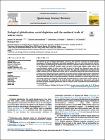| dc.contributor.author | Barrett, James | |
| dc.date.accessioned | 2020-03-21T10:09:55Z | |
| dc.date.available | 2020-03-21T10:09:55Z | |
| dc.date.issued | 2020 | |
| dc.date.submitted | 2020 | en |
| dc.identifier.citation | James H. Barrett, Sanne Boessenkool, Catherine J. Kneale, Tamsin C. O’Connell, Bastiaan Star, 'Ecological globalisation, serial depletion and the medieval trade of walrus rostra', 2020, Quaternary Science Reviews;, 229; | en |
| dc.identifier.issn | 02773791 | |
| dc.identifier.other | Y | |
| dc.identifier.uri | http://hdl.handle.net/2262/91845 | |
| dc.description | PUBLISHED [GOLD] | en |
| dc.description.abstract | The impacts of early ecological globalisation may have had profound economic and environmental consequences for human settlements and animal populations. Here, we review the extent of such historical impacts by investigating the medieval trade of walrus (Odobenus rosmarus rosmarus) ivory. We use an interdisciplinary approach including chaîne opératoire, ancient DNA (aDNA), stable isotope and zooarchaeological analysis of walrus rostra (skull sections) to identify their biological source and sub- sequent trade through Indigenous and urban networks. This approach complements and improves the spatial resolution of earlier aDNA observations, and we conclude that almost all medieval European finds of walrus rostra likely derived from Greenland. We further find that shifting urban nodes redistributed the traded ivory and that the latest medieval rostra finds were from smaller, often female, walruses of a distinctive DNA clade, which is especially prevalent in northern Greenland. Our results suggest that more and smaller animals were targeted at increasingly untenable distances, which reflects a classic pattern of resource depletion. We consider how the trade of walrus and elephant ivory intersected, and evaluate the extent to which emergent globalisation and the “resource curse” contributed to the abandonment of Norse Greenland. | en |
| dc.description.sponsorship | This work was supported by the Leverhulme Trust [MRF-2013-065], United Kingdom; Nansenfondet and the Research Council of Norway [projects 262777 and 230821], Norway. | en |
| dc.format.extent | 106 | en |
| dc.format.extent | 122 | en |
| dc.language.iso | en | en |
| dc.relation.ispartofseries | Quaternary Science Reviews; | |
| dc.relation.ispartofseries | 229; | |
| dc.rights | Y | en |
| dc.subject | Europe | en |
| dc.subject | Greenland | en |
| dc.subject | Ecological globalisation | en |
| dc.subject | Historical ecology | en |
| dc.subject | Archaeology | en |
| dc.subject | Stable isotopes | en |
| dc.subject | Ancient DNA | en |
| dc.subject | Middle Ages | en |
| dc.title | Ecological globalisation, serial depletion and the medieval trade of walrus rostra | en |
| dc.type | Journal Article | en |
| dc.relation.references | References | en |
| dc.type.supercollection | scholarly_publications | en |
| dc.type.supercollection | refereed_publications | en |
| dc.identifier.peoplefinderurl | http://people.tcd.ie/barretjh | |
| dc.identifier.rssinternalid | 215022 | |
| dc.identifier.doi | https://doi.org/10.1016/j.quascirev.2019.106122 | |
| dc.rights.ecaccessrights | openAccess | |
| dc.relation.doi | https://doi.org/10.1016/j.quascirev.2019.106122. | en |
| dc.subject.TCDTheme | Smart & Sustainable Planet | en |
| dc.contributor.sponsor | Leverhulme Trust | en |
| dc.contributor.sponsorGrantNumber | MRF-2013-065 | en |
| dc.contributor.sponsor | Nansenfondet and the Research Council of Norway | en |
| dc.contributor.sponsorGrantNumber | 262777 | en |
| dc.contributor.sponsor | Nansenfondet and the Research Council of Norway | en |
| dc.contributor.sponsorGrantNumber | 230821 | en |




